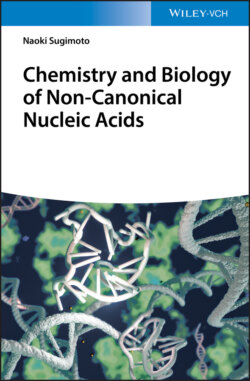Читать книгу Chemistry and Biology of Non-canonical Nucleic Acids - Naoki Sugimoto - Страница 51
3.4.2.2 i-Motif
ОглавлениеC-rich sequences have been shown to form i-motif structures – a second type of quadruplex structure containing intercalated cytosine-protonated cytosine base pairs coupled together with looping base (Figure 3.10a) [12]. For example, the i-motif DNA tetrameric structure is formed of two parallel duplexes intercalated in a head-to-tail orientation and held together by hemiprotonated cytosine pairs (Figure 3.10b). The four phosphodiester backbones forming the structure define two narrow and wide grooves. The short interphosphate distances across the narrow groove and the charged C-imino protons induce a strong repulsion that should destabilize the i-motif. On the other hand, attractive interactions are observed between C-C pairs. Attractive interactions are also expected between C4–N4 and C2–O2 dipoles of stacked C-C pairs, which are nearly antiparallel in the i-motif structures, and between the N3 and H1 atoms of the cytosines forming a hemiprotonated C-C pair. The sum of all attractive interactions between the bases can thus compensate for the C-imino proton repulsion. Moreover, the twisting of the phosphodiester backbone is critical for the i-motif stability, and therefore all the phosphodiester backbones should display the same twist to produce a good stacking of bases. An i-motif structure of RNA is very unstable due to rigidity of backbones; therefore, the i-motif structures that are revealed by structural analysis such as NMR or X-ray analysis are composed of DNA.
Figure 3.10 (a) Hydrogen bond formation in base pairs in a DNA i-motif. The hydrogen bonds are shown in dashed lines. (b) i-Motif structures of DNAs are depicted in tube (left) and ball-and-stick (right) models, respectively. Stacking interactions are shown in arrows.
Due to a strong repulsion of negative charges in the i-motif, the cations can bind i-motif groove. It is reported that the choline ions bind to around narrow groove in the i-motif and the binding induces large stabilization of the i-motif in the solution with neutral pH [13].
